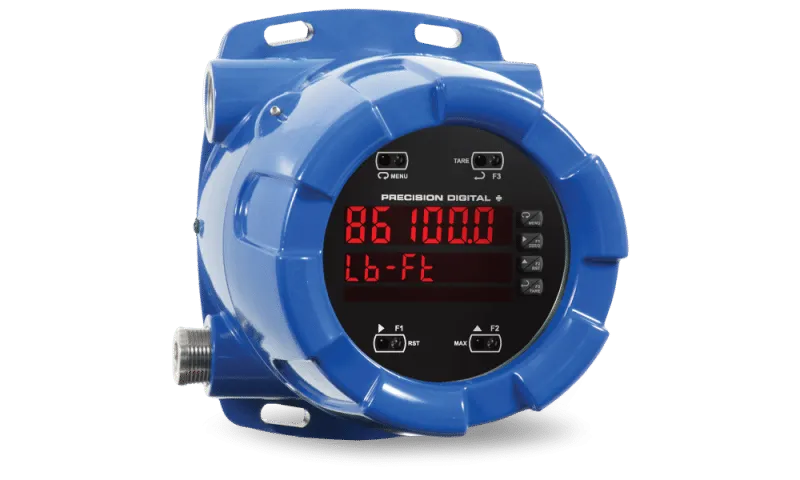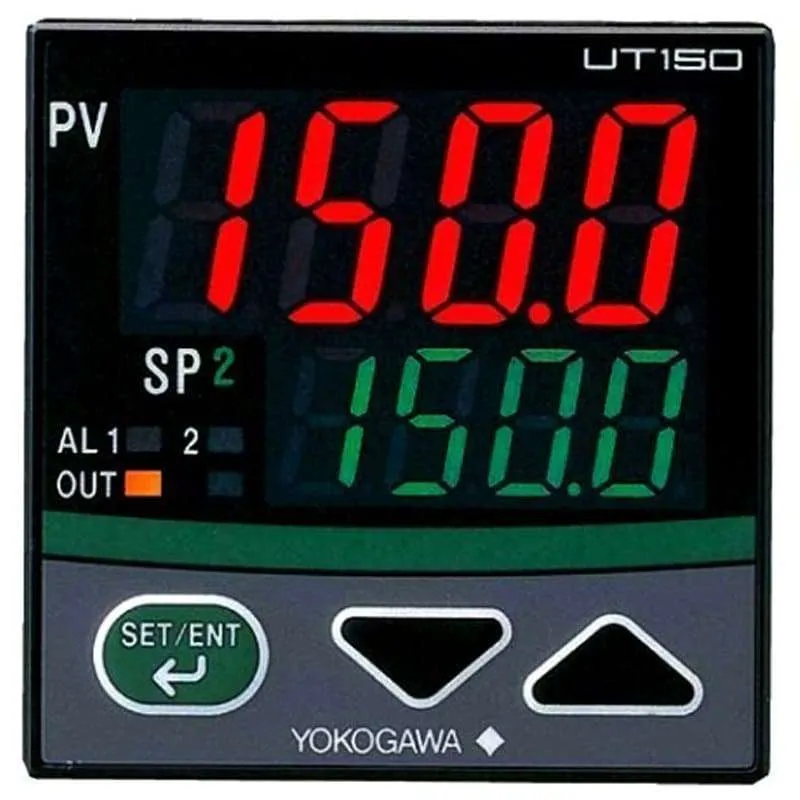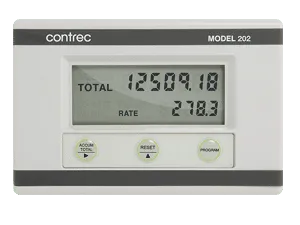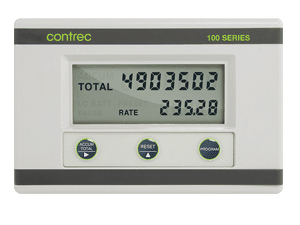The Precision Digital ProtEX-MAXTM PD8-6100 offers all the functionality of the ProVu PD6100 as a fully FM, CSA, ATEX, and IECEx approved explosion-proof product. It accepts strain gauge & load cell inputs and mV signals up to 300 mV (unipolar) and ± 250 mV (bipolar) for weight and force measurement applications. The PD8-6100 strain gauge meter’s dual-line display and powerful dual-scale capability allow the measurement to be displayed in two different measurement units. Another use for the PD8-6100’s dual-lines is simply displaying the units of measure on the bottom line. SafeTouch®through-glass buttons allow for access to zero, tare, and other functions without the need to remove the enclosure cover. The PD8-6100 includes a 5 or 10 VDC power supply to drive the sensors and can be equipped with up to four internal relays and two 4-20 mA outputs.
Precision Digital PD8-6100 Strain Gauge, Load Cell mV Meter
Quick Overview
- Input: 0-10, 0-20, ±10, ±20, ±100, ±200 mV; Modbus PV (slave)
- Display: Dual-line 6-digit, 0.60″ (15 mm) & 0.46″ (12 mm)
- Enclosure: Smooth die-cast aluminum explosion-proof; NEMA 4X, 7, 9/IP68
- Power: 85-265 VAC or 12-24 VDC option
- Operating Temperature: -40 to 65°C
Features
- SunBright Display Standard
- Selectable 5 or 10 VDC excitation power supply
- Capture or programmable tare feature
- Ratiometric operation
- Dual-scale feature – single input
- Rounding function 1, 2, 5, 10, 20, 50, or 100
- Auto-zero feature eliminates zero drift
- SafeTouch® through-glass button programming
- Modbus RS-485 serial communications
- Flanges for wall or pipe mounting
- Onboard USB and MeterView® Pro programming software
General
Display:Upper display: 0.60″ (15 mm) high. Lower display: 0.46″ (12 mm) high. Both are 6 digits (-99999 to 999999), red LEDs.
Display Intensity: Eight intensity levels
Display Update Rate: 5/second (200 ms)
Overrange: Display flashes 999999
Underrange: Display flashes -99999
Display Assignment: The upper and lower displays may be assigned to PV1, PV2, PCT (percent), max/min, alternate max & min, set points, units (lower display only), or Modbus input.
Programming Methods: Four through-glass SafeTouch buttons, four mechanical buttons behind glass, digital inputs, PC and MeterView Pro software, or Modbus registers.
F4 Digital Input Contacts: 3.3 VDC on contact. Connect normally open contacts across F4 to COM.
F4 Digital Input Logic Levels: Logic High: 3 to 5 VDC; Logic Low: 0 to 1.25 VDC
Noise filter: Programmable from 2 to 199 (0 will disable filter)
Filter Bypass: Programmable from 0.1 to 99.9% of calibrated span
Recalibration: Calibrated at the factory. Recalibration is recommended at least every 12 months.
Max/Min Display: Max / min readings reached by the process are stored until reset by the user or until power to the meter is turned off.
Password: Three programmable passwords restrict modification of programmed settings.
Non-Volatile Memory: All programmed settings are stored in nonvolatile memory for a minimum of ten years if power is lost.
Input Power Options: 85-265 VAC 50/60 Hz, 90-265 VDC, 20 W max, or optional sku with 12-24 VDC ±10%, 15 W max.
Fuse: Required external fuse: UL Recognized, 5 A max, slow blow; up to 6 meters may share one 5 A fuse.
Normal Mode Rejection: Greater than 60 dB at 50/60 Hz
Isolation: 4 kV input/output-to-power line. 500 V input-to-output or output-to-P+ supply.
Overvoltage Category: Installation Overvoltage Category II: Local level with smaller transient overvoltages than Installation Overvoltage Category III.
Environmental:
T6 Class operating temperature range Ta = -40 to 60°C
T5 Class operating temperature range Ta = -40 to 65°C
Max Power Dissipation: Maximum power dissipation limited to 15.1 W. See PD8 instruction manual for additional details.
Connections: Removable screw terminal blocks accept 12 to 22 AWG wire, RJ45 for external relays, digital I/O, and serial communication adapters.
Enclosure: Explosion-proof die cast aluminum with glass window, corrosion resistant epoxy coating, color: blue. NEMA 4X, 7, & 9, IP68. Default conduit connections: Four ¾” NPT threaded conduit openings and two ¾” NPT metal conduit plugs with 12 mm hex key fitting installed. Additional conduit opening configurations may be available; verify quantity and sizes on specific device labeling during installation.
Mounting: Four slotted flanges for wall mounting or NPS 1½” to 2½” or DN 40 to 65 mm pipe mounting
Dimensions: 6.42″ x 7.97″ x 8.47″ (W x H x D) (163 mm x 202 mm x 215 mm)
Weight: 16.0 lbs (7.26 kg)
Warranty: 3 years parts & labor
USB Connection: Compatibility: USB 2.0 Standard, Compliant
Connector Type: Micro-B receptacle
Cable: USB A Male to Micro-B Cable
Driver: Windows 98/SE, ME, 2000, Server 2003/2008, XP 32/64-Bit,
Vista 32/64-Bit, Windows 7 32/64-Bit, Windows 10 32/64-Bit
Power: USB Port
Strain Gauge Input
Inputs: Field selectable: 0-15, 0-30, 0-150, 0-300 mV, ±15, ±25, ±150, ±250 mV, or Modbus PV (Slave)
Accuracy: ±0.03% of calibrated span ±1 count
Temperature Drift: 0.002% of calibrated span/°C max from 0 to 65°C ambient, 0.005% of calibrated span/°C max from -30 to 0°C ambient
Function: Linear with multi-point linearization
Low-Flow Cutoff: 0-999999 (0 disables cutoff function)
Decimal Point: Up to five decimal places or none: d.ddddd, dd.dddd, ddd.ddd, dddd.dd, ddddd.d, or dddddd.
Calibration Range:
| Input Range | Minimum Span Input 1 & Input 2 |
| 15 mV | 0.2 mV |
| 25 mV, 30 mV | 0.4 mV |
| 150 mV | 2.0 mV |
| 250 mV, 300 mV | 4.0 mV |
An Error message will appear if the input 1 and input 2 signals are too close together.
Input Impedance: Voltage ranges: greater than 1 MΩ.
Isolated Excitation Power Supply: Terminals Ex+ & Ex- may be used for sensor excitation, 10 VDC or 5 VDC ±10% @ 25 mA max. Field selectable for 10 VDC excitation voltage to operate up to two 1000 Ω strain gauges, or 5 VDC excitation voltage to operate up to four 1000 Ω strain gauges or one 350 Ω strain gauge.
For safe area only, not agency approved installations, Ex+ & Ex- may be used for sensor excitation; 10 VDC or 5 VDC ±10% @ 350 mA max.
Relays
Rating: 2 or 4 SPDT (Form C) internal and/or 4 SPST (Form A) external; rated 3 A @ 30 VDC and 125/250 VAC resistive load; 1/14 HP (≈ 50 watts) @ 125/250 VAC for inductive loads such as contactors, solenoids, etc.
Noise Suppression: Noise suppression is recommended for each relay contact switching inductive loads.
Deadband: 0-100% of span, user programmable
High or Low Alarm: User may program any alarm for high or low trip point. Unused alarm LEDs and relays may be disabled (turned off).
Relay Operation: Automatic (non-latching), latching (requires manual acknowledge), sampling (based on time), pump alternation control (2 to 8 relays), Off (disable unused relays and enable interlock feature, manual on/off control mode).
Relay Reset: User selectable via front panel buttons or digital inputs.
1. Automatic reset only (non-latching), when input passes the reset point.
2. Automatic + manual reset at any time (non-latching).
3. Manual reset only, at any time (latching).
4. Manual reset only after alarm condition has cleared (latching).
Note: Front panel button or digital input may be assigned to acknowledge relays programmed for manual reset.
Time Delay: 0 to 999.9 seconds, on & off relay time delays. Programmable and independent for each relay.
Fail-Safe Operation: Programmable and independent for each relay.
Auto Initialization: When power is applied to the meter, relays will reflect the state of the input to the meter.
Serial Communications
Compatability: EIA-485
Connectors: Removable screw terminal connector
Max Distance: 3,937′ (1,200 m) max
Status Indication: Separate LEDs for Power (P), Transmit (TX), and Receive (RX)
Protocol: Modbus® RTU (Slave Only)
Meter Address/Slave ID: 1 – 247
Baud Rate: 300 – 19,200 bps
Transmit Time Delay: Programmable between 0 and 199 ms or transmitter always on for RS-422 communication
Data: 8 bit (1 start bit, 1 or 2 stop bits)
Parity: Even, odd, or none with 1 or 2 stop bits
Byte-to-Byte Timeout: 0.01 – 2.54 seconds
Turn Around Delay: Less than 2 ms (fixed)
Note: Refer to the ProVu Modbus Register Tables for details
Isolated 4-20 mA Transmitter Output
Output Source: Process variable (PV), max, min, set points 1-8, manual control setting, or Modbus input
Scaling Range: 1.000 to 23.000 mA for any display range
Calibration: Factory calibrated: 4.000 to 20.000 = 4-20 mA output
Analog Output Programming: 23.000 mA maximum for all parameters:
Overrange, underrange, max, min, and break
Accuracy: ± 0.1% of span ± 0.004 mA
Temperature Drift: 0.4 µA/°C max from 0 to 65°C ambient, 0.8 µA/°C max from -40 to 0°C ambient
Note: Analog output drift is separate from input drift.
Isolated Transmitter Power Supply: Terminals I+ & R: 24 VDC ± 10%. Isolated from the input at >500 V. May be used to power the 4-20 mA output or other devices (except load cell/strain gauge). All skus @ 25 mA max.
External Loop Power Supply: 35 VDC maximum
Output Loop Resistance:
| Power supply | Minimum | Maximum |
| 24 VDC | 10Ω | 700Ω |
| 35 VDC (external) | 100Ω | 1200Ω |
Digital Inputs and Outputs
Channels: 4 digital inputs & 4 digital outputs per module
System: One expansion module may be added for a total of 8 inputs & 8 outputs
Note: The jumper located between the RJ45 connectors must be removed on the expansion module.
Digital Input Logic: High: 3 to 5 VDC; Low: 0 to 1.25 VDC
Digital Output Logic: High: 3.1 to 3.3 VDC; Low: 0 to 0.4 VD
Source Current: 10 mA maximum output current
Sink Current: 1.5 mA minimum input current
+5 V Terminal: To be used as pull-up for digital inputs only. Connect normally open pushbuttons across +5 V & DI 1-4. Warning: DO NOT use +5 V terminal (pin 1) to power external devices.
Function Assignment: The on-board digital inputs (1-4) are designed to mimic the behavior of the front panel buttons (Menu, F1, F2, & F3). If you wish to change their behavior, re-assign F1-F3 to the desired function, then change the corresponding digital input to match.
4-Relay Expansion Module
Relays: Four Form A (SPST) rated 3 A @ 30 VDC and 125/250 VAC resistive load; 1/14 HP (approx. 50 watts) @ 125/250 VAC for inductive loads.
Product Ratings and Approvals
FM Enclosure: Type 4X; IP66
Class I, Division 1, Groups B, C, D
Class II, Division 1, Groups E, F, G
Class III, Division 1, T5/T6
Class I, Zone 1, AEx d, IIC Gb T5/T6
Zone 21, AEx tb IIIC T90°C; Ta -40°C to +65°C
T6 Ta = -40°C to +60°C; T5 Ta = -40°C to +65°C
Certificate Number: 3047283
CSA: Class I, Division 1, Groups B, C, D
Class II, Division 1, Groups E, F, G
Class III, Division 1
Class I Zone 1 Ex d IIC
Zone 21 Ex tb IIIC T90°C
-40°C < Tamb. < +60° C; Temperature Code T6
-40°C < Tamb. < +65° C; Temperature Code T5
Enclosure Type 4X & IP66
Certificate Number: 2531731
ATEX: II 2 G D Ex d IIC T* Gb
Ex tb IIIC T90°C Db IP68
Ta = -40°C to +*°C
*T6 = -40°C to +60°C
*T5 = -40°C to +65°C
Certificate number: Sira 12ATEX1182
IECEx: Ex d IIC T* Gb
Ex tb IIIC T90°C Db IP68
Ta = -40°C to +*°C
*T6 = -40°C to +60°C
*T5 = -40°C to +65°C
Certificate Number: IECEx SIR 12.0073
Dimensions
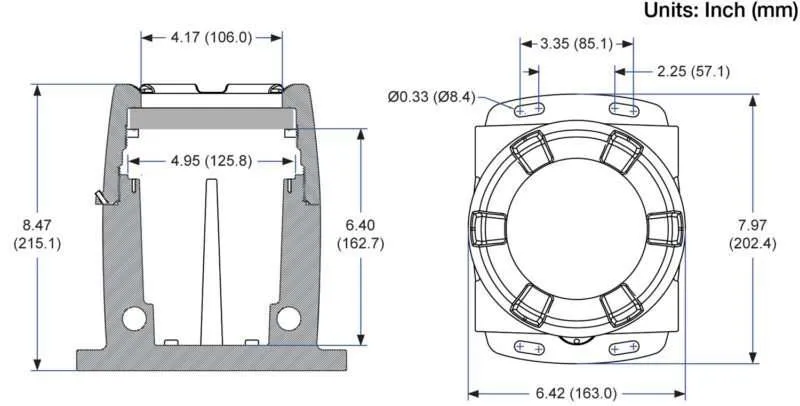
Application
Load Cell
A typical application for load cells is in a tank weighing operation. In the following example, this three-legged tank has a load cell under each leg. The three load cells are wired locally in parallel within a junction box. The combined signals are then connected to the PD8-6100. During field calibration, the weight of the empty tank (zero point) and the full tank weight (full scale) are programmed into the meter. Over time, the tare feature on the PD8-6100 can account for obstacles like sludge buildup on the bottom of the tank when empty.
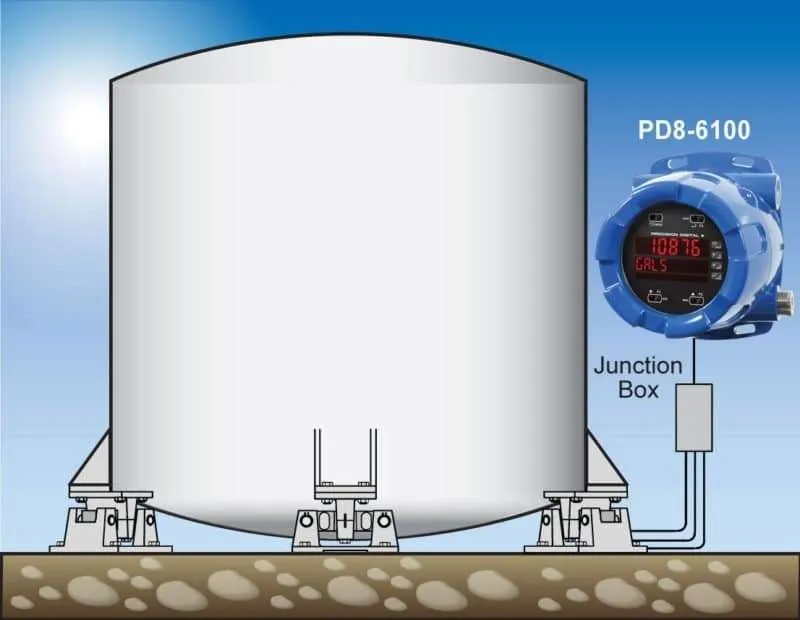
MeterView® Pro Software
 MeterView® Pro software is designed for use with ProVu, ProtEX-MAX, or Helios Series meters and allows users to remotely program, monitor, and datalog using a PC. Remote programming allows for all available meter settings to be programmed through an easy, user-friendly interface. The data acquisition feature allows the user to gather readings from a meter at user-selected intervals and generate charts using common tools like Microsoft® Excel. A linearization setup function is also included. With this utility the user can configure up to 32 linearization points and upload them to the meter. All configuration data can be saved to a file for future use.
MeterView® Pro software is designed for use with ProVu, ProtEX-MAX, or Helios Series meters and allows users to remotely program, monitor, and datalog using a PC. Remote programming allows for all available meter settings to be programmed through an easy, user-friendly interface. The data acquisition feature allows the user to gather readings from a meter at user-selected intervals and generate charts using common tools like Microsoft® Excel. A linearization setup function is also included. With this utility the user can configure up to 32 linearization points and upload them to the meter. All configuration data can be saved to a file for future use.
This software is accessible via the onboard USB connection on all Helios large display meters, ProVu panel meters, and ProVu-based ProtEX-MAX explosion-proof meters produced since 6 September 2016 (firmware version 4.0 or higher). In order for meters produced prior to 6 September 2016 (firmware version 3.1 or lower) to establish digital communications with a PC, a serial communications adapter is required. For an RS-232 connection, use a PDA1232adapter.
To determine the software version of a meter:
- Go to the Diagnostics menu (
 ) and press Enter button.
) and press Enter button. - Press Up arrow button and scroll to Information menu (Info
 ).
). - Press Enter to access the software number (
 ), version (
), version ( ), and serial number (
), and serial number ( ) information. Write down the information as it is displayed. Continue pressing Enter until all the information is displayed.
) information. Write down the information as it is displayed. Continue pressing Enter until all the information is displayed. - The meter returns to Run Mode after displaying all the settings.
Monitor and Datalog
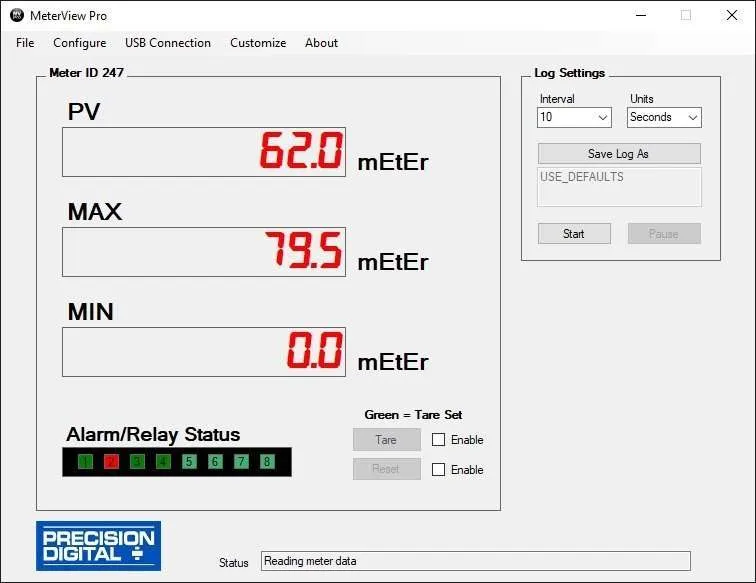
Setup
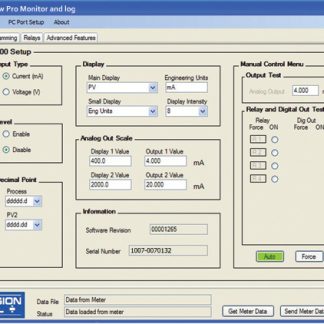
Programming
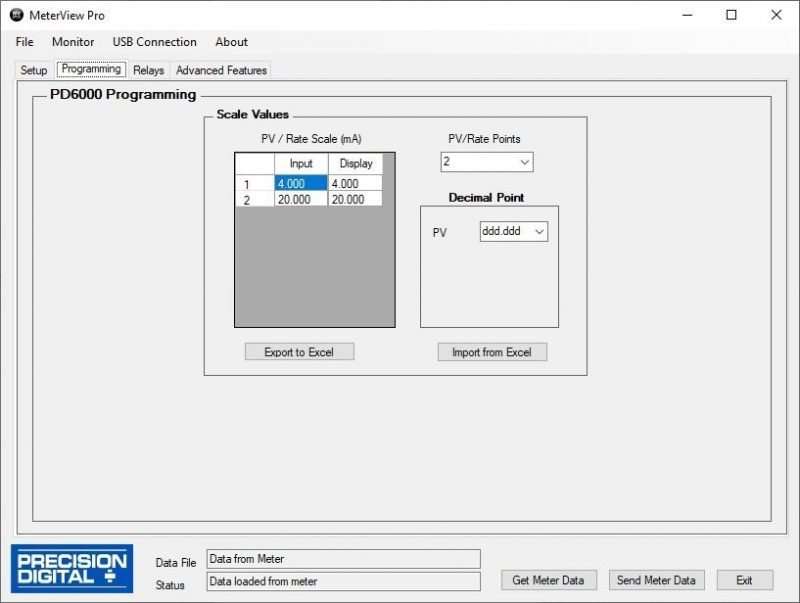
Relays
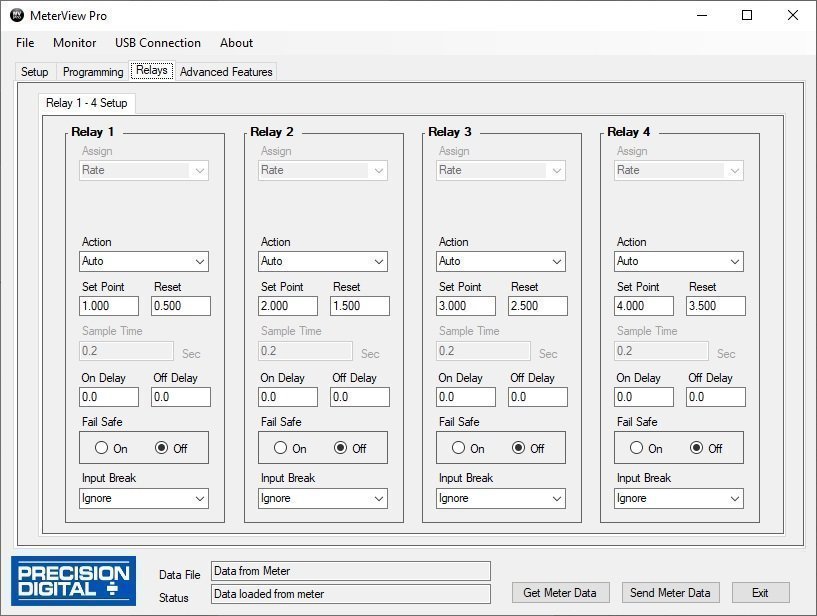
Data Sheet: LDS8-6100_0 Datasheets
Instruction Manual: LIM8-6100_0 Instruction Manuals

